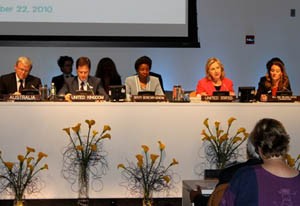The Alliance for Reproductive, Maternal and Newborn Health was launched at the United Nations General Assembly in 2010 by three governments – the United States (US Agency for International Development, USAID), the United Kingdom (Department of International Development, DFID), Australia (then the Agency for International Development, AusAID, and (now the Department of Foreign Affairs and Trade, DFAT), – plus the Bill and Melinda Gates Foundation. The partnership’s goals were to accelerate progress in achieving Millennium Development Goals (MDGs) 4 and 5 which focused on improving reproductive, maternal and child health outcomes and sought to do this to coordinate cost-effective use of resources, leverage resources, reduce duplication, and encourage the sharing of best practices among partners.
Alliance partners have worked together for five years and today, with the changes in the global donor framework, now is an appropriate time to bring the Alliance to a close.
The short but rich history of the Alliance marks strong advances in donor coordination, a collaboration that has led to other partnerships, notably the Ouagadougou Partnership and FP 2020.
This page not only provides an historical review of the achievements of the Alliance but also provides a documentation of best practices in donor collaboration.

Read the Alliance's yearly progress reports:
- Year One Report – September 2011 [PDF, 2.0MB]
- Year Two Report – September 2012 [PDF, 230KB]
- Year Three Report – February 2015 [PDF, 340KB]
- Final Report – March 2016 [PDF, 2.0MB]
In support of Family Planning 2020, the Alliance and the World Health Organization hosted the first Family Planning Implementation Research Donor Meeting in Washington, D.C., December 3-4, 2012. The meeting brought together more than 40 representatives from 21 funding agencies that identified research gaps that could be addressed through collective action, and outlined the initial strategies for doing so. This meeting marked the emergence of greater donor collaboration on family planning implementation research, and recognized that many of the remaining questions in the field call for aligned responses that draw on the comparative advantages of a range of development partners. In preparation for the meeting, the Population Council prepared a background paper, which reviewed and synthesized the large body of existing family planning research and identified key knowledge gaps, and a donor brief about international family planning research collaboration.
- Reviewing the Evidence and Identifying Gaps in Family Planning Research [PDF, 2.7MB]
- Launching collaboration on family planning research among the international donor community [PDF, 209KB]
In an effort to review the current state of evidence on adolescent contraceptive access and make the case for further investments in research, the Alliance published an 80-page paper [PDF, 2MB], including detailed appendices, and a 4-page policy brief [PDF, 307KB]. These publications address the cost and impact of pregnancy and childbirth among adolescents; and the benefits of contraceptive use by that age group. The rationales for directing more funding to research and evaluation of adolescent contraceptive use are laid out, including how adolescent contraception fits with other global health priorities, and the value new evidence can offer to targeting program expenditures in the most effective ways possible. Specific research needs are highlighted as priorities, including market segmentation, operations research on promising practices and facilitating the transfer of research to programs.
- The Case for Investing in Research to Increase Access to and Use of Contraception among Adolescents [PDF, 2MB]
- Policy Brief on the Case for Investing in Research to Increase Access to and Use of Contraception among Adolescents [PDF, 307KB]
On October 28th, 2015, the Alliance organized an event entitled "What Works in Adolescent Contraceptive Service Delivery: What We Know and What We Still Need to Know," which is available to view via an archived webinar. The first panel presented three new materials, one commissioned under the auspices of the Alliance, and two from the USAID High Impact Practices series. "The Case for Investing in Research to Increase Access to and Use of Contraception Among Adolescents" was presented by Margaret E. Greene. The USAID publications include "Adolescent-Friendly Contraceptive Services: Mainstreaming Adolescent-Friendly Elements Into Existing Contraceptive Services," presented by Jill Gay; and "Improving Sexual and Reproductive Health of Young People: A Strategic Planning Guide," presented by Shawn Malarcher. The second panel offered perspectives from four donors: Cate Lane, USAID; Clarissa Lord Brundage, Bill and Melinda Gates Foundation; Zaza Curran, DFID; and Rafael Cortez, World Bank.
In collaboration with the Partnership for Maternal, Newborn, and Child Health (PMNCH), USAID’s flagship Maternal and Child Health Integrated Program, and the World Health Organization, Alliance partners jointly supported a series of national reviews on current progress and challenges in addressing key policy and implementation issues related to reproductive, maternal, newborn and child health (RMNCH).
- Read the results of these analyses.
- Review how implementation analysis has been used to identify national RMNCH priorities [PDF, 1.6MB].
- More background on implementation from PMNCH.
Exemplifying the international focus on donor harmonization and country ownership of development, the Alliance closely coordinates the efforts of partners to support country strategies to scale-up proven, high-impact interventions and to explore and adapt innovations that can advance health outcomes.
- Read about the Alliance's Kenya partnership [PDF, 2MB].
U.S. Secretary of State Hillary Clinton, U.K. Deputy Prime Minister Nick Clegg, Australia Foreign Minister Kevin Rudd, and Melinda Gates, co-chair of the Bill & Melinda Gates Foundation announced at the MDG Summit in New York September 22, 2010, the five-year public/private global alliance to: 1) contribute to the goal of reducing the unmet need for family planning by 100 million women; 2) expand skilled birth attendance and facility-based deliveries; and 3) increase the numbers of women and newborns receiving quality post-natal care by 2015. Read remarks on the Alliance at UN Secretary General Ban Ki-moon's Millennium Development Goals' Maternal and Child Health Event - 09/22/10:
- Secretary of State Hillary Clinton
- Nick Clegg, Deputy Prime Minister, UK [PDF, 23KB]
- Australian Foreign Minister Kevin Rudd
- Melinda Gates







Comment
Make a general inquiry or suggest an improvement.